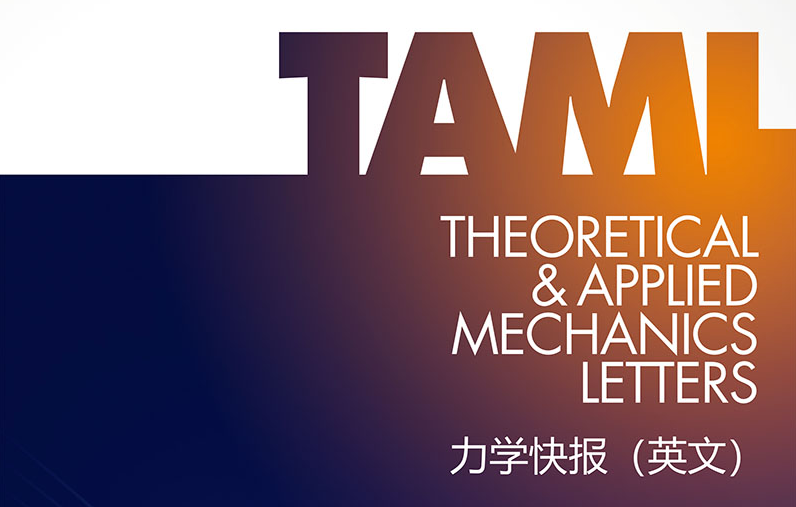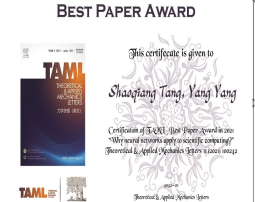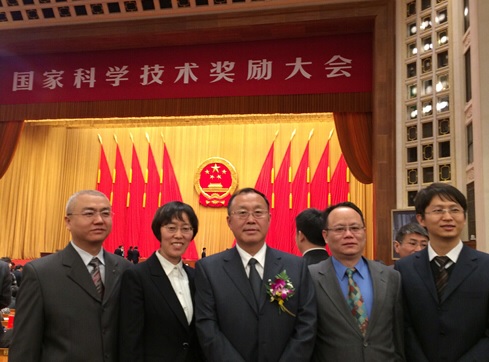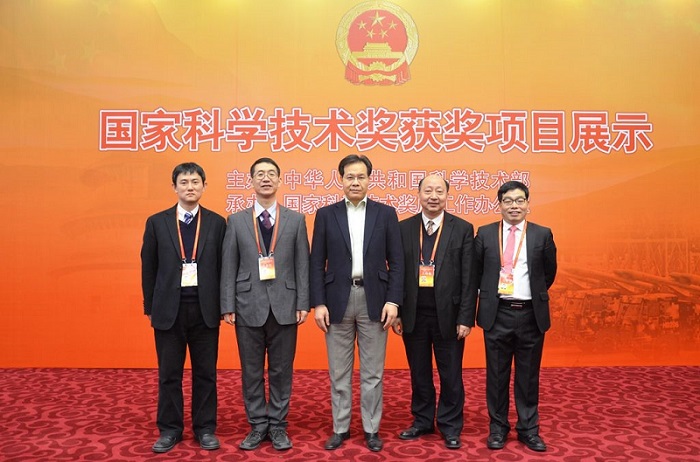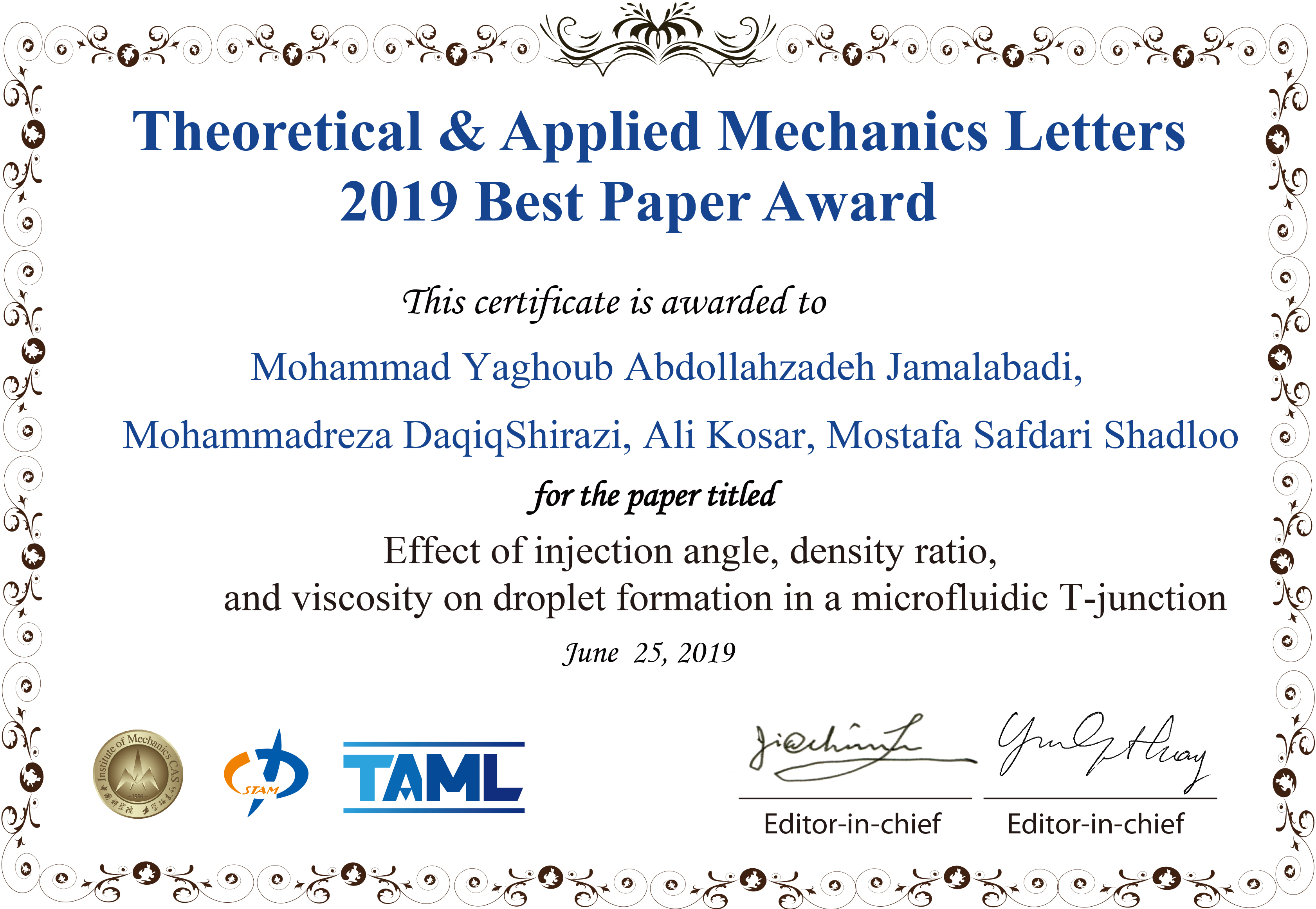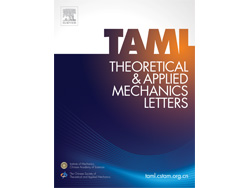Institute of Mechanics,
Chinese Academy of Sciences
2023 Vol.13(3)
Display Mode: |
Theoretical and Applied Mechanics Letters 13 (2023) 100397.
doi: 10.1016/j.taml.2022.100397
Abstract:
The study of a flexible body immersed in a flowing medium is one of the best way to find its aerodynamic shape. This Letter revisited the problem that was first studied by Alben et al. (Nature 420, 479–481, 2002). To determine the aerodynamic shape of the fibre, a simpler approach is proposed. A universal drag scaling law is obtained and the universality of the Alben-Shelley-Zhang scaling law is confirmed by using dimensional analysis. A complete Maple code is provided for finding aerodynamic shape of the fibre in the flowing medium.
The study of a flexible body immersed in a flowing medium is one of the best way to find its aerodynamic shape. This Letter revisited the problem that was first studied by Alben et al. (Nature 420, 479–481, 2002). To determine the aerodynamic shape of the fibre, a simpler approach is proposed. A universal drag scaling law is obtained and the universality of the Alben-Shelley-Zhang scaling law is confirmed by using dimensional analysis. A complete Maple code is provided for finding aerodynamic shape of the fibre in the flowing medium.
Theoretical and Applied Mechanics Letters 13 (2023) 100419.
doi: 10.1016/j.taml.2022.100419
Abstract:
In a global dynamic analysis, the coexisting attractors and their basins are the main tools to understand the system behavior and safety. However, both basins and attractors can be drastically influenced by uncertainties. The aim of this work is to illustrate a methodology for the global dynamic analysis of nondeterministic dynamical systems with competing attractors. Accordingly, analytical and numerical tools for calculation of nondeterministic global structures, namely attractors and basins, are proposed. First, based on the definition of the Perron-Frobenius, Koopman and Foias linear operators, a global dynamic description through phase-space operators is presented for both deterministic and nondeterministic cases. In this context, the stochastic basins of attraction and attractors’ distributions replace the usual basin and attractor concepts. Then, numerical implementation of these concepts is accomplished via an adaptative phase-space discretization strategy based on the classical Ulam method. Sample results of the methodology are presented for a canonical dynamical system.
In a global dynamic analysis, the coexisting attractors and their basins are the main tools to understand the system behavior and safety. However, both basins and attractors can be drastically influenced by uncertainties. The aim of this work is to illustrate a methodology for the global dynamic analysis of nondeterministic dynamical systems with competing attractors. Accordingly, analytical and numerical tools for calculation of nondeterministic global structures, namely attractors and basins, are proposed. First, based on the definition of the Perron-Frobenius, Koopman and Foias linear operators, a global dynamic description through phase-space operators is presented for both deterministic and nondeterministic cases. In this context, the stochastic basins of attraction and attractors’ distributions replace the usual basin and attractor concepts. Then, numerical implementation of these concepts is accomplished via an adaptative phase-space discretization strategy based on the classical Ulam method. Sample results of the methodology are presented for a canonical dynamical system.
Theoretical and Applied Mechanics Letters 13 (2023) 100422.
doi: 10.1016/j.taml.2022.100422
Abstract:
The paper studies stochastic dynamics of a two-degree-of-freedom system, where a primary linear system is connected to a nonlinear energy sink with cubic stiffness nonlinearity and viscous damping. While the primary mass is subjected to a zero-mean Gaussian white noise excitation, the main objective of this study is to maximise the efficiency of the targeted energy transfer in the system. A surrogate optimisation algorithm is proposed for this purpose and adopted for the stochastic framework. The optimisations are conducted separately for the nonlinear stiffness coefficient alone as well as for both the nonlinear stiffness and damping coefficients together. Three different optimisation cost functions, based on either energy of the system’s components or the dissipated energy, are considered. The results demonstrate some clear trends in values of the nonlinear energy sink coefficients and show the effect of different cost functions on the optimal values of the nonlinear system’s coefficients.
The paper studies stochastic dynamics of a two-degree-of-freedom system, where a primary linear system is connected to a nonlinear energy sink with cubic stiffness nonlinearity and viscous damping. While the primary mass is subjected to a zero-mean Gaussian white noise excitation, the main objective of this study is to maximise the efficiency of the targeted energy transfer in the system. A surrogate optimisation algorithm is proposed for this purpose and adopted for the stochastic framework. The optimisations are conducted separately for the nonlinear stiffness coefficient alone as well as for both the nonlinear stiffness and damping coefficients together. Three different optimisation cost functions, based on either energy of the system’s components or the dissipated energy, are considered. The results demonstrate some clear trends in values of the nonlinear energy sink coefficients and show the effect of different cost functions on the optimal values of the nonlinear system’s coefficients.
Theoretical and Applied Mechanics Letters 13 (2023) 100432.
doi: 10.1016/j.taml.2023.100432
Abstract:
Extensive improvements in small-scale thermal systems in electronic circuits, automotive industries, and microcomputers conduct the study of microsystems as essential. Flow and thermic field characteristics of the coherent nanofluid-guided microchannel heat sink are described in this perusal. The porous media approximate was used to search the heat distribution in the expanded sheet and Cu: γ - ALOOH/Water. A hybrid blend of Boehme copper and aluminum nanoparticles is evaluated to have a cooling effect on the microchannel heat sink. By using Akbari Ganji and finite element methods, linear and non-linear differential equations as well as simple dimensionless equations have been analyzed. The purpose of this study is to investigate the fluid and thermal parameters of copper hybrid solution added to water, such as Nusselt number and Darcy number so that we can reach the best cooling of the fluid. Also, by installing a piece of fin on the wall of the heat sink, the coefficient of conductive heat transfer and displacement heat transfer with the surrounding air fluid increases, and the efficiency of the system increases. The overall results show that expanding values on the NP (Series heat transfer fluid system maximizes performance with temperatures) volume division of copper, as well as boehmite alumina particles, lead to a decrease within the stream velocity of the Cu: ALOOH/Water. Increasing the volume fraction of nanoparticles in the hybrid mixture decreases the temperature of the solid surface and the hybrid nanofluid. The Brownian movement improves as the volume percentage of nanoparticles in the hybrid mixture grows, spreading heat across the environment. As a result, heat transmission rates rise. As the Darcy number increases, the thermal field for solid sections and Cu: ALOOH/Water improves.
Extensive improvements in small-scale thermal systems in electronic circuits, automotive industries, and microcomputers conduct the study of microsystems as essential. Flow and thermic field characteristics of the coherent nanofluid-guided microchannel heat sink are described in this perusal. The porous media approximate was used to search the heat distribution in the expanded sheet and Cu: γ - ALOOH/Water. A hybrid blend of Boehme copper and aluminum nanoparticles is evaluated to have a cooling effect on the microchannel heat sink. By using Akbari Ganji and finite element methods, linear and non-linear differential equations as well as simple dimensionless equations have been analyzed. The purpose of this study is to investigate the fluid and thermal parameters of copper hybrid solution added to water, such as Nusselt number and Darcy number so that we can reach the best cooling of the fluid. Also, by installing a piece of fin on the wall of the heat sink, the coefficient of conductive heat transfer and displacement heat transfer with the surrounding air fluid increases, and the efficiency of the system increases. The overall results show that expanding values on the NP (Series heat transfer fluid system maximizes performance with temperatures) volume division of copper, as well as boehmite alumina particles, lead to a decrease within the stream velocity of the Cu: ALOOH/Water. Increasing the volume fraction of nanoparticles in the hybrid mixture decreases the temperature of the solid surface and the hybrid nanofluid. The Brownian movement improves as the volume percentage of nanoparticles in the hybrid mixture grows, spreading heat across the environment. As a result, heat transmission rates rise. As the Darcy number increases, the thermal field for solid sections and Cu: ALOOH/Water improves.
Theoretical and Applied Mechanics Letters 13 (2023) 100433.
doi: 10.1016/j.taml.2023.100433
Abstract:
The solution of fractional-order systems has been a complex problem for our research. Traditional methods like the predictor-corrector method and other solution steps are complicated and cumbersome to derive, which makes it more difficult for our solution efficiency. The development of machine learning and nonlinear dynamics has provided us with new ideas to solve some complex problems. Therefore, this study considers how to improve the accuracy and efficiency of the solution based on traditional methods. Finally, we propose an efficient and accurate nonlinear auto-regressive neural network for the fractional order dynamic system prediction model (FODS-NAR). First, we demonstrate by example that the FODS-NAR algorithm can predict the solution of a stochastic fractional order system. Second, we compare the FODS-NAR algorithm with the famous and good reservoir computing (RC) algorithms. We find that FODS-NAR gives more accurate predictions than the traditional RC algorithm with the same system parameters, and the residuals of the FODS-NAR algorithm are closer to 0. Consequently, we conclude that the FODS-NAR algorithm is a method with higher accuracy and prediction results closer to the state of fractional-order stochastic systems. In addition, we analyze the effects of the number of neurons and the order of delays in the FODS-NAR algorithm on the prediction results and derive a range of their optimal values.
The solution of fractional-order systems has been a complex problem for our research. Traditional methods like the predictor-corrector method and other solution steps are complicated and cumbersome to derive, which makes it more difficult for our solution efficiency. The development of machine learning and nonlinear dynamics has provided us with new ideas to solve some complex problems. Therefore, this study considers how to improve the accuracy and efficiency of the solution based on traditional methods. Finally, we propose an efficient and accurate nonlinear auto-regressive neural network for the fractional order dynamic system prediction model (FODS-NAR). First, we demonstrate by example that the FODS-NAR algorithm can predict the solution of a stochastic fractional order system. Second, we compare the FODS-NAR algorithm with the famous and good reservoir computing (RC) algorithms. We find that FODS-NAR gives more accurate predictions than the traditional RC algorithm with the same system parameters, and the residuals of the FODS-NAR algorithm are closer to 0. Consequently, we conclude that the FODS-NAR algorithm is a method with higher accuracy and prediction results closer to the state of fractional-order stochastic systems. In addition, we analyze the effects of the number of neurons and the order of delays in the FODS-NAR algorithm on the prediction results and derive a range of their optimal values.
Theoretical and Applied Mechanics Letters 13 (2023) 100436.
doi: 10.1016/j.taml.2023.100436
Abstract:
Stochastic fractional differential systems are important and useful in the mathematics, physics, and engineering fields. However, the determination of their probabilistic responses is difficult due to their nonMarkovian property. The recently developed globally-evolving-based generalized density evolution equation (GE-GDEE), which is a unified partial differential equation (PDE) governing the transient probability density function (PDF) of a generic path-continuous process, including non-Markovian ones, provides a feasible tool to solve this problem. In the paper, the GE-GDEE for multi-dimensional linear fractional differential systems subject to Gaussian white noise is established. In particular, it is proved that in the GE-GDEE corresponding to the state-quantities of interest, the intrinsic drift coefficient is a time-varying linear function, and can be analytically determined. In this sense, an alternative low-dimensional equivalent linear integer-order differential system with exact closed-form coefficients for the original highdimensional linear fractional differential system can be constructed such that their transient PDFs are identical. Specifically, for a multi-dimensional linear fractional differential system, if only one or two quantities are of interest, GE-GDEE is only in one or two dimensions, and the surrogate system would be a one- or two-dimensional linear integer-order system. Several examples are studied to assess the merit of the proposed method. Though presently the closed-form intrinsic drift coefficient is only available for linear stochastic fractional differential systems, the findings in the present paper provide a remarkable demonstration on the existence and eligibility of GE-GDEE for the case that the original high-dimensional system itself is non-Markovian, and provide insights for the physical-mechanism-informed determination of intrinsic drift and diffusion coefficients of GE-GDEE of more generic complex nonlinear systems.
Stochastic fractional differential systems are important and useful in the mathematics, physics, and engineering fields. However, the determination of their probabilistic responses is difficult due to their nonMarkovian property. The recently developed globally-evolving-based generalized density evolution equation (GE-GDEE), which is a unified partial differential equation (PDE) governing the transient probability density function (PDF) of a generic path-continuous process, including non-Markovian ones, provides a feasible tool to solve this problem. In the paper, the GE-GDEE for multi-dimensional linear fractional differential systems subject to Gaussian white noise is established. In particular, it is proved that in the GE-GDEE corresponding to the state-quantities of interest, the intrinsic drift coefficient is a time-varying linear function, and can be analytically determined. In this sense, an alternative low-dimensional equivalent linear integer-order differential system with exact closed-form coefficients for the original highdimensional linear fractional differential system can be constructed such that their transient PDFs are identical. Specifically, for a multi-dimensional linear fractional differential system, if only one or two quantities are of interest, GE-GDEE is only in one or two dimensions, and the surrogate system would be a one- or two-dimensional linear integer-order system. Several examples are studied to assess the merit of the proposed method. Though presently the closed-form intrinsic drift coefficient is only available for linear stochastic fractional differential systems, the findings in the present paper provide a remarkable demonstration on the existence and eligibility of GE-GDEE for the case that the original high-dimensional system itself is non-Markovian, and provide insights for the physical-mechanism-informed determination of intrinsic drift and diffusion coefficients of GE-GDEE of more generic complex nonlinear systems.
Theoretical and Applied Mechanics Letters 13 (2023) 100437.
doi: 10.1016/j.taml.2023.100437
Abstract:
As a kind of classical low-frequency sound-absorbing material, the microperforated plate (MPP) has been widely used. Here, we inspired by the sound absorption mechanism of the MPP, a spiral metasurface (SM) is designed and the analytical solution of acoustic impedance and sound absorption coefficient are obtained. The relationship between the sound absorption properties of the MPP and the SM with their own structures is systematically studied, and the analytical solutions are used to optimise the structure. It is concluded that the MPP and the SM of the same thickness achieve effective absorption in the frequency range between 390-900 Hz and 1920-4266 Hz, with a total thickness less than 1/6 of the wavelength. Meanwhile, the numerical calculation shows that the MPP and SM can match well with the background medium in the effective rang. Our study provides new insights into the design methods of sound-absorbing materials and is potentially suitable for many acoustic engineering applications.
As a kind of classical low-frequency sound-absorbing material, the microperforated plate (MPP) has been widely used. Here, we inspired by the sound absorption mechanism of the MPP, a spiral metasurface (SM) is designed and the analytical solution of acoustic impedance and sound absorption coefficient are obtained. The relationship between the sound absorption properties of the MPP and the SM with their own structures is systematically studied, and the analytical solutions are used to optimise the structure. It is concluded that the MPP and the SM of the same thickness achieve effective absorption in the frequency range between 390-900 Hz and 1920-4266 Hz, with a total thickness less than 1/6 of the wavelength. Meanwhile, the numerical calculation shows that the MPP and SM can match well with the background medium in the effective rang. Our study provides new insights into the design methods of sound-absorbing materials and is potentially suitable for many acoustic engineering applications.
Theoretical and Applied Mechanics Letters 13 (2023) 100438.
doi: 10.1016/j.taml.2023.100438
Abstract:
The interaction of multiple bubbles is a complex physical problem. A simplified case of multiple bubbles is studied theoretically with a bubble located at the center of a circular bubble cluster. All bubbles in the cluster are equally spaced and own the same initial conditions as the central bubble. The unified theory for bubble dynamics (Zhang et al. arXiv:2301.13698) is applied to model the interaction between the central bubble and the circular bubble cluster. To account for the effect of the propagation time of pressure waves, the emission source of the wave is obtained by interpolating the physical information on the time axis. An underwater explosion experiment with two bubbles of different scales is used to validate the theoretical model. The effect of the bubble cluster with a variation in scale on the pulsation characteristics of the central bubble is studied.
The interaction of multiple bubbles is a complex physical problem. A simplified case of multiple bubbles is studied theoretically with a bubble located at the center of a circular bubble cluster. All bubbles in the cluster are equally spaced and own the same initial conditions as the central bubble. The unified theory for bubble dynamics (Zhang et al. arXiv:2301.13698) is applied to model the interaction between the central bubble and the circular bubble cluster. To account for the effect of the propagation time of pressure waves, the emission source of the wave is obtained by interpolating the physical information on the time axis. An underwater explosion experiment with two bubbles of different scales is used to validate the theoretical model. The effect of the bubble cluster with a variation in scale on the pulsation characteristics of the central bubble is studied.
Theoretical and Applied Mechanics Letters 13 (2023) 100439.
doi: 10.1016/j.taml.2023.100439
Abstract:
Velocity oscillations at the head of the gravity current were investigated in experiments and numerical simulations of a locked-exchange flow. A comparison of the experimental and numerical simulations showed that the depth and volume of the released fluid affected the oscillations in the velocity of the gravity current. At the initial stage, the head moved forward at a constant velocity, and velocity oscillations occurred. The head maximum thickness increased at the same time as the head, which did not have a round, and accumulated buoyant fluid due to the buoyancy effect intrusion force. The period of accumulation and release of the buoyant fluid was almost the same as that observed for the head movement velocity; the head movement velocity was faster when the buoyant fluid accumulated and slower when it was released. At the viscous stage, the forward velocity decreased proportionally to the power of 1/2 of time, since the head was not disturbed from behind. As the mass concentration at the head decreased, the gravity current was slowed by the viscous stage in its effect. At the viscous stage, the mass concentration at the head was no longer present, and the velocity oscillations also decreased.
Velocity oscillations at the head of the gravity current were investigated in experiments and numerical simulations of a locked-exchange flow. A comparison of the experimental and numerical simulations showed that the depth and volume of the released fluid affected the oscillations in the velocity of the gravity current. At the initial stage, the head moved forward at a constant velocity, and velocity oscillations occurred. The head maximum thickness increased at the same time as the head, which did not have a round, and accumulated buoyant fluid due to the buoyancy effect intrusion force. The period of accumulation and release of the buoyant fluid was almost the same as that observed for the head movement velocity; the head movement velocity was faster when the buoyant fluid accumulated and slower when it was released. At the viscous stage, the forward velocity decreased proportionally to the power of 1/2 of time, since the head was not disturbed from behind. As the mass concentration at the head decreased, the gravity current was slowed by the viscous stage in its effect. At the viscous stage, the mass concentration at the head was no longer present, and the velocity oscillations also decreased.
Theoretical and Applied Mechanics Letters 13 (2023) 100450.
doi: 10.1016/j.taml.2023.100450
Abstract:
This work applies concepts of artificial neural networks to identify the parameters of a mathematical model based on phase fields for damage and fracture. Damage mechanics is the part of the continuum mechanics that models the effects of micro-defect formation using state variables at the macroscopic level. The equations that define the model are derived from fundamental laws of physics and provide important relationships among state variables. Simulations using the model considered in this work produce good qualitative and quantitative results, but many parameters must be adjusted to reproduce certain material behavior. The identification of model parameters is considered by solving an inverse problem that uses pseudo-experimental data to find the best values that fit the data. We apply physics informed neural network and combine some classical estimation methods to identify the material parameters that appear in the damage equation of the model. Our strategy consists of a neural network that acts as an approximating function of the damage evolution with output regularized using the residue of the differential equation. Three stages of optimization seek the best possible values for the neural network and the material parameters. The training alternates between the fitting of only the pseudo-experimental data or the total loss that includes the regularizing terms. We test the robustness of the method to noisy data and its generalization capabilities using a simple physical case for the damage model. This procedure deals better with noisy data in comparison with a more standard PDE-constrained optimization method, and it also provides good approximations of the material parameters and the evolution of damage.
This work applies concepts of artificial neural networks to identify the parameters of a mathematical model based on phase fields for damage and fracture. Damage mechanics is the part of the continuum mechanics that models the effects of micro-defect formation using state variables at the macroscopic level. The equations that define the model are derived from fundamental laws of physics and provide important relationships among state variables. Simulations using the model considered in this work produce good qualitative and quantitative results, but many parameters must be adjusted to reproduce certain material behavior. The identification of model parameters is considered by solving an inverse problem that uses pseudo-experimental data to find the best values that fit the data. We apply physics informed neural network and combine some classical estimation methods to identify the material parameters that appear in the damage equation of the model. Our strategy consists of a neural network that acts as an approximating function of the damage evolution with output regularized using the residue of the differential equation. Three stages of optimization seek the best possible values for the neural network and the material parameters. The training alternates between the fitting of only the pseudo-experimental data or the total loss that includes the regularizing terms. We test the robustness of the method to noisy data and its generalization capabilities using a simple physical case for the damage model. This procedure deals better with noisy data in comparison with a more standard PDE-constrained optimization method, and it also provides good approximations of the material parameters and the evolution of damage.
Theoretical and Applied Mechanics Letters 13 (2023) 100455.
doi: 10.1016/j.taml.2023.100455
Abstract:
 Submit a Paper
Submit a Paper
 Subscription
Subscription
News
MORE+
Call for Papers
MORE+
- Crossing-Mechanics Driven by Big Data
- Machine learning in the fluid mechanics research of wind energy
- Mechanics of Origami/Kirigami structures and metamaterials
- New insights and perspectives on impact biomechanics for human tissues: from injury prevention, protection to protective equipment
- Environmental Mechanics for Extreme Natural Events









